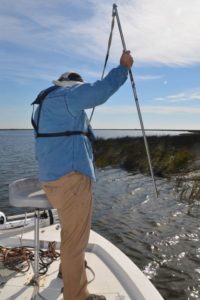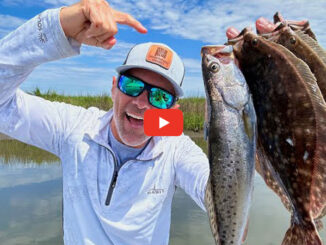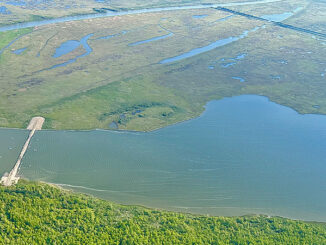
Live shrimp, popping corks, crimped leaders and a snap swivel did the trick for specks on a windy day out of Delacroix.
The wind was blowing like the Seven Trumpets of Revelation.
I didn’t know if we’d catch any fish, but I knew we wouldn’t get lost.
After all, I was fishing with a famous cartographer: Roy Williams, who makes fishing maps and has the whole coast plotted out on his computer.
For years, he supplied the maps that Louisiana Sportsman writer Rusty Tardo’s articles were famous for. He’s also the guy who produced the fishing maps for the popular speckled trout book Trout Masters Too: How the Pros Do It.
That’s how I met him.
But it wasn’t pretty when we launched at Sweetwater Marina in Delacroix. However, the forecast at least called for the wind to drop at least a little.
I crossed my fingers.
At the wheel of the boat was Lenny Barrios, Williams’ lifelong friend since junior high school. The two 60-year olds are exiles from the New Orleans neighborhoods they grew up in, Williams to Metairie and Barrios to Meraux.
“I prefer to fish bass now,” said Barrios with an ‘I’ve got a Secret’ grin. “But we’ve been fishing speckled trout and redfish all our lives. At one time, bass fishing was taboo in New Orleans.

“They were trash fish. People didn’t fish a lot of green trout. They were considered ‘northern fish.’”
“We had so much saltwater around us that we didn’t bother with fresh water,” agreed Williams. “Lenny got me started on bass. He thinks that he still has me in training.”
The pair started fishing as young men in Lake Catherine and Unknown Pass. Also, Barrios’ family owned a camp in Buras and they did a lot of weekend fishing trips there.
“Now we fish a lot out of Bayou Bienvenue and Bayou Thomas,” said Williams. “This time of year it’s down here — the inner marshes of Delacroix.”
“Fishing out of Delacroix in November and December is excellent,” agreed Barrios. “Good bottom fishing with soft plastics.”
“The average size trout is bigger here than in the summer, when the bigger fish are outside. And there are less gnats and bugs to put up with, too,” laughed Williams.
Tactics for the wind

“A good thing is that you can always find protected waters, even on windy days,” noted Barrios. “I had to have a strategy for today because I knew we were going to have wind. The spots I picked last night were all with the bank and wind to my back.
“I looked in Roy’s book and compared that to my experiences. I knew I wanted eastern shorelines.”
Our first stop was where the Twin Pipelines opened into Four Horse Lake (page 11 in the Delacroix Guide book). It was well-marked in blue, signifying specks.
Barrios got his spot, but he wasn’t overly excited about the bait choice. Air and water temperatures had been high, so he called for live shrimp.
“You can’t go wrong with live bait, but I’m the world’s worst cork fisherman. I’m slow. I like the thump of bottom fishing.”
There was nothing exotic or fancy in how they rigged out. This was old-school fishing. Both used weighted popping corks. Williams used something rarely seen nowadays in the fishing world, where speckled trout are viewed as eagle-eyed wraiths.
He used a big ole snap swivel.

“I never find that it hurts fishing,” he shrugged, “and it makes it so easy to change baits or hooks.”
Barrios’ approach was equally old school. He crimped his hook onto a heavy leader using a metal sleeve.
And no invisible and expensive fluorocarbon here — both used 12-pound Trilene Big Game monofilament line.
One thing unusual that both used were 3/0 red kahle hooks. “I prefer a red hook,” dead-panned Barrios. “It’s supposed to resemble blood — a wounded bait. But I really think that it’s a confidence factor thing.
“Anything that might help…,” tossed off Williams with a grin.
Williams and Barrios began a steady rhythm of catching 14- to 16-inch fish, with an occasional 12-incher thrown in just to keep them on their toes. It wasn’t a slaughter — a fish every cast — but with the regular pace, trout definitely accumulated in the box.
Each shrimp was hooked beneath the ridged horn on top of its head, and they were fished by regular pops of the popping cork. Fishing was made easy, both by the wind laying down somewhat and Barrios’ care to select spots on lee shores. The wind behind their backs made casting the cumbersome popping corks easier. But their success soon attracted other boats.
Seeing red(s)
Like trout fishing anywhere, a bent rod acted like heroin to an addict. Slowing the boat down and trying to figure out a way to muscle in on someone else’s success in finding fish — all the while exhibiting embarrassed courtesy — was the rule.
The normally affable Barrios grumbled in a low voice. “I’m not a social fisherman. I don’t want to be around other boats.”

With that as a cue, the pair huddled to pore over the Nevalost Guide to pick another marked spot to go to. This action was to be often repeated throughout the day.
Their routine to approach each spot was similar. Barrios killed the big motor at least 50 yards from where he wanted to fish, then trolled into position. “I believe that in speckled trout fishing, the quieter you are, the better.
“Best of all, I like to play the wind and drift without using the trolling motor.” But that wasn’t possible because of their desire to fish lee shores. The wind would simply push them further from the shore, rather than nearer it, forcing them to cast up-wind.
Once in position, Williams speared the Cajun anchor in the marsh bottom. Quieter than other anchors and cheaper than Power-Pole type anchors, a Cajun anchor was ideal for the soft mud bottoms of the area.
They repeated the routine at each spot, digging out speckled trout with popping corks and shrimp until they attracted other boats. Then it was up-anchor and move again.
By 11 it was still windy enough to be aggravating, and the trout were scattered at each stop. They acted bored with the action and conferred about hitting on redfish. I suspected Williams wanted to show that the red-marked spots in the Nevalost Guide worked, too.
Using the same equipment and bait, they began to connect on redfish, although in more sheltered spots. They followed the usual routine for redfish, casting to near the bank rather than to open water where trout lurk.
They were successful on redfish, too. To Barrios’ chagrin, Williams nailed three in a row from a single point in the marsh grass.
Point made, the pair quit early and headed to the fish cleaning station at Barrios’ St. Bernard Parish home. They chatted about their next bass trip while they worked.
I waited for an invitation.


